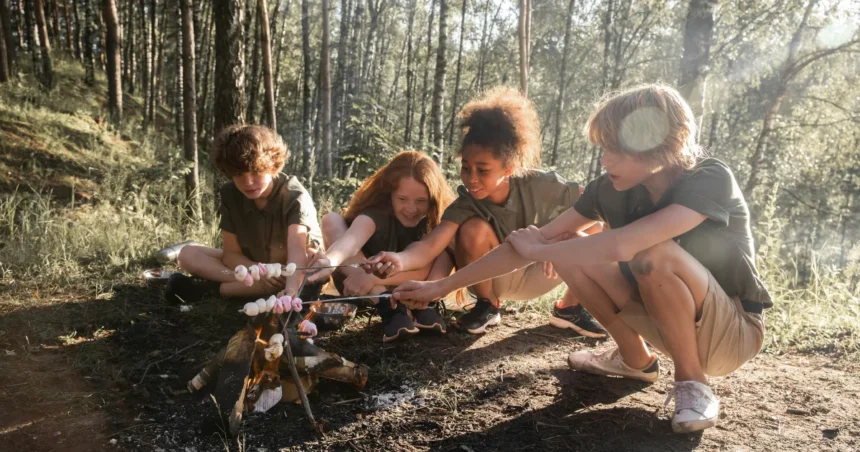Humor plays a vital role in bringing people together, boosting confidence, and fostering creativity. But what happens when kids start experimenting with “roasts” – the playful, good-natured insults that are popular in comedy routines and social media banter? Roasting is not just for professionals; when done right, it can be a lighthearted activity that kids enjoy, helping them develop wit and social skills. However, without proper boundaries, roasts can veer into harmful territory.
This blog explores everything parents, educators, and childcare providers need to know about navigating the trend of roasts for kids. From setting guidelines to encouraging positive use of roast humor, we’ll cover how to make this experience fun, safe, and beneficial for the young ones in your care.
What Are Roasts for Kids? Are They Appropriate?
Roasting, in its basic form, involves making funny, often exaggerated remarks about someone or something. Think of it as playful teasing—but the golden rule is that it’s meant to be delivered and received in good spirit. While roasting among kids can be tricky, it has gained notable traction as a way for children to express their sense of humor in schoolyards, at sleepovers, or during family game nights.
The big question is, are roasts appropriate for kids? The answer depends on the context and the boundaries set around them. When done with clear guidelines, roasts can:
- Improve creative thinking
- Encourage lighthearted social interaction
- Help kids learn to laugh at themselves, a valuable life skill.
However, things can go south if children roast inappropriately, crossing into bullying or hurting someone’s feelings. The key is ensuring that parties involved are mature enough to distinguish between harmless jokes and remarks that could be potentially mean-spirited.
Guidelines for Safe and Fun Roasts
To make roasts an enjoyable activity and keep the atmosphere constructive, it’s important to set some ground rules. Here are guidelines you can use to help kids roast responsibly:
1. Always Keep It Lighthearted
Ensure the roasts are about harmless traits like someone’s favorite food, funny preferences, or quirky habits. No insults rooted in personal appearance, race, gender, or body type should be allowed. For example:
- Acceptable: “Oh, James never met a French fry he didn’t like!”
- Unacceptable: “You’re the shortest kid in the class!”
2. Consent is Key
Before engaging in a roast session, everyone involved should give their approval. No one should be forced to participate. Make it clear that kids can opt out at any time if they don’t feel comfortable.
3. Know Your Limits
Set an upper boundary for how long a roast session can last or how many jokes can be exchanged in one evening. This keeps it from escalating.
4. Teach How to Apologize
Even with the best intentions, some jokes might still unintentionally hurt feelings. Teach kids how to recognize when they’ve crossed a line and how to apologize sincerely.
5. Follow Up with Positivity
Balance the roasts with compliments. A good rule of thumb? For every roast, offer a kind affirmation. For instance:
- Roast: “Wow, Emma’s favorite color is yellow because nobody else wanted it!”
- Compliment: “But she’s the best at making everyone smile, just like sunshine!”
Age-Appropriate Roast Examples
To help you get started with lighthearted and safe roasts, here’s a list of kid-friendly examples that stay on the fun side of humor:
Simple, harmless roasts:
- “Oh, you sang ‘Happy Birthday’ so loud last year, we’re still recovering!”
- “Liam loves pizza so much, he’d marry it if he could!”
- “Sophia names her pencils… don’t ask what happened to Pencil Pete.”
Food-related roasts:
- “Your lunch smells so good… is that where you hide vegetables?”
- “You eat cereal for dinner? Bookmarking that for my life hacks list!”
School-themed roasts:
- “Last time Ethan answered a tough math problem, the calculator cried for help!”
- “You know the teacher’s mad when they ask Sarah for homework advice!”
Sibling-friendly roasts:
- “My brother uses my stuff so often; I’m surprised he hasn’t borrowed my birthday!”
- “When my sister helps me bake, she eats all the chocolate and calls it quality control.”
These examples maintain a lighthearted tone and ensure no jokes target sensitive areas. Feel free to tweak for personality and context!
The Benefits of Allowing Kids to Roast
While roasting might feel risky on the surface, it can come with surprising benefits for children when practiced appropriately.
1. Builds Confidence
Roasting allows kids to handle humor directed at them and develop the ability to laugh at themselves. This skill is invaluable for building emotional maturity and resilience when faced with challenges.
2. Encourages Creativity and Wit
Coming up with clever and humorous roasts requires quick thinking and creativity. Over time, this promotes critical thinking ability and sharpens communication skills.
3. Supports Social Bonding
Playful humor fosters camaraderie and strengthens interpersonal relationships. Well-received roasts often become shared moments of laughter among peers or families.
4. Teaches Emotional Cues
Kids learn important lessons about empathy and reading emotions by participating in roasts. Positive interactions show them how to spot when someone’s comfortable versus when they’ve gone too far.
Should Parents Allow Roasting?
Based on its potential benefits, roasting can be a constructive activity for kids when it’s done correctly. However, it’s not something to introduce lightly without preparation. Here’s your checklist to determine if roasting fits into your child’s social routine:
- Your Child’s Maturity: Ensure they can differentiate between playful teasing and unkind remarks.
- Clear Boundaries: Create a safe set of rules. Teach kids what’s fun versus what’s hurtful.
- Follow-Up Discussion: Check in after roast sessions to gauge how everyone feels. This ensures no one was unintentionally hurt or left feeling excluded.
Allowing roasts for kids is ultimately a balancing act between fun humor and emotional sensitivity. The goal is to create an environment where laughter is shared, lessons are learned, and everyone leaves with a smile.






